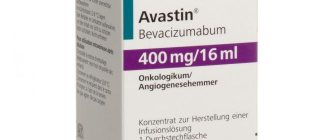The drug Trental, which improves blood circulation, is produced in the form of tablets and a concentrated solution for infusion. The cost of the medicine depends on the form of the medicine and packaging. You can buy Trental at a price of 100-300 rubles per package.
The active substance in pentoxifylline is a xanatine derivative. The component is contained in the following quantities:
- 100 mg, 400 mg in soluble film-coated tablets.
- 20 mg in one ml solution for infusion.
In order to exclude possible allergic reactions when taking the product, it is necessary to pay attention to the auxiliary components that were used to create the drug. Trental instructions also contain all recommendations for use and focus on contraindications.
Effects of the drug and indications
The drug trental, the instructions for use indicate, reduces blood viscosity and improves its fluidity. The active substance has a slight myotropic vasodilator effect. Such combinations of properties help, after taking the drug, to improve microcirculation in areas where circulatory disorders are observed. The active substance in the medicine is quickly absorbed into the gastrointestinal tract, which guarantees a quick effect. When smoking, the therapeutic effect of the drug is significantly reduced.
Trental tablets are indicated for use in cases of impaired peripheral circulation due to the development of atherosclerosis. Its effectiveness has been proven in a pathology known as “intermittent” claudication. This insidious pathology can immobilize a person at any time. Its main symptom is acute pain in the legs, caused by deterioration of blood circulation in the arteries and their narrowing.
Trental 100 is also prescribed, the instructions confirm this, for trophic disorders. The medicine alleviates the condition of patients with trophic ulcers, which often occur against the background of varicose veins and thrombophlebitis. The drug is indicated in the complex treatment of gangrene and frostbite.
It is recommended to use trental for cerebrovascular accidents. This pathology can be provoked by cerebral atherosclerosis. Symptoms of the disease are the following:
- Inability to concentrate.
- The occurrence of periodic dizziness.
- Problems remembering simple information.
Ischemic and post-stroke conditions are also indications for the drug. When using the drug, it is possible to improve the condition of patients against the background of rapid restoration of blood flow. Indications are degenerative changes in pathologies of the vessels of the inner ear, which lead to hearing loss.
Dosage
The dose and method of administration are determined by the doctor after examining the patient. In this case, the severity of the circulatory disorder against the background of a specific disease and the person’s condition must be taken into account. Treatment must be carried out under strict control of blood pressure.
According to the instructions attached to the drug, oral administration is permitted in accordance with the following recommendations:
- Treatment intake: 3 tablets (100 mg) three times a day.
- Possible increase in dosage to 6 (100 mg) tablets three times a day.
- The maximum single dose is no more than 2 (100 mg) tablets.
Tablets are usually indicated for maintenance therapy. They are taken after meals. They must be swallowed with plenty of clean water. If there are pathologies of the kidneys and liver, then the dosage is reduced by 2 times. There are also other recommendations in the instructions that need to be studied.
The infusion solution is prepared from 100 - 600 mg of medication. It is diluted in 0.9% sodium chloride solution (250 - 500 ml). Droppers are placed 1-2 times a day. It is imperative to test for compatibility when using other infusion solutions.
Instructions for use TRENTAL
The dose and route of administration depend on the type and severity of circulatory disorders and individual tolerance to the drug.
Inside
prescribed in doses of up to 800-1200 mg/day in 2-3 doses, after meals. Enteric-coated tablets are swallowed whole with a small amount of water. The daily dose is divided into 3 doses. The initial dose is 600 mg/day. As the condition improves, the dose can be reduced to 300 mg/day. Prolonged dosage forms are prescribed 2-3 times a day.
The drug can be administered orally simultaneously with parenteral administration. In addition to the infusion of Trental, delayed-release tablets may be added. If the clinical condition improves, treatment can be continued with extended-release tablets.
IV in the form of infusions
the drug is administered on average 200-300 mg (2-3 ampoules of 5 ml) per day (morning and afternoon). A concentrated solution of the drug in ampoules is diluted in 250-500 ml of infusion solution.
After the daily infusion, an additional 2 delayed-release tablets may be prescribed. If the two infusions are separated by a longer interval, then 1 extended-release tablet of the additional two prescribed may be taken earlier, around noon.
If, in accordance with the clinical situation, intravenous infusions are possible only once a day, then additionally after the infusion, 3 delayed-release tablets can be prescribed (2 delayed-release tablets at noon and 1 in the evening).
Long-term intravenous infusion of Trental for 24 hours is indicated in more severe cases, especially in patients with severe pain at rest, with gangrene or ulceration (Fontan stages III-IV).
When administered parenterally within 24 hours, the dose of Trental, as a rule, should not exceed 1.2 g, with an individual dose prescribed at the rate of 600 mcg/kg/h. The daily dose calculated in this way will be 1000 mg of pentoxifylline for a patient weighing 70 kg and 1150 mg of pentoxifylline for a patient weighing 80 kg.
In patients with impaired renal function (creatinine clearance less than 30 ml/min)
A dose reduction of 30-50% may be required, depending on individual tolerability of the drug.
A dose reduction based on individual tolerance is necessary in patients with severe liver dysfunction
.
For patients with low blood pressure, as well as those at risk for arterial hypotension (with severe coronary artery disease or hemodynamically significant stenoses of the cerebral vessels), the drug is prescribed in small doses at the beginning of treatment, and a gradual dose increase is possible in the future.
Rules for the preparation and administration of infusion solution
The concentrated solution for preparing a solution for infusion must be diluted in appropriate solvents:
- saline or Ringer's solution. Testing for compatibility with other infusion solutions should be carried out separately. Only clear solutions can be used.
Trental 100 mg should be administered at least 60 minutes before.
Depending on concomitant diseases (heart failure), it may be necessary to reduce the injected volumes. In such cases, it is recommended to use a special pump to control the volume of infusions.
Contraindications
An absolute contraindication is intolerance to the active substance and other components in the medication. The drug is not prescribed for people under the age of 18, as well as during pregnancy and lactation. Other contraindications for Trental 100, the instructions for use focus on:
- Severe bleeding of any etiology.
- Hemorrhages in the brain and retina.
- Myocardial infarction.
With extreme caution and only after assessing the patient’s condition, the drug is prescribed for the following pathologies:
- Cardiac arrhythmia.
- Low blood pressure.
- Chronic heart failure.
- Stomach and duodenal ulcers.
- Kidney failure.
- Liver pathologies.
Do not use the medicine after surgery, or if you are prone to bleeding.
TRENTAL concentrate for the preparation of solution for infusion 20 mg/ml ampoule 5 ml No. 5
The dose and regimen of use are determined by the severity of circulatory disorders, as well as taking into account the individual tolerability of the drug and the characteristics of the patient. The drug is administered intravenously as an infusion 2 times a day, morning and afternoon. A single dose (per 1 infusion) is 200 mg of pentoxifylline (2 ampoules of 5 ml) or 300 mg of pentoxifylline (3 ampoules of 5 ml) in 250 ml or 500 ml of 0.9% sodium chloride solution or Ringer's solution. Compatibility with other infusion solutions should be tested separately; Only clear solutions can be used. The 100 mg dose should be administered but at least over 60 minutes. Depending on concomitant diseases (heart failure), it may be necessary to reduce the injected volume. In such cases, it is recommended to use a special infuser for controlled infusion. After the daily infusion, an additional 2 tablets may be prescribed. Trental 400. If 2 infusions are separated by a longer interval, then 1 tab. Trental 400 of the two additionally prescribed can be taken earlier (at approximately noon). If, due to clinical conditions, intravenous infusion is possible only once a day, an additional 3 tablets may be prescribed after it. Trentala 400 (2 tablets - at noon and 1 tablet - in the evening). Long-term intravenous infusion of Trental for 24 hours is indicated in more severe cases, especially in patients with severe pain at rest, with gangrene or trophic ulcers (stages III-IV according to Fontaine). The dose of Trental when administered parenterally over 24 hours, as a rule, should not exceed 1200 mg, while the individual dose can be calculated using the formula: 600 mcg/kg body weight per hour. The daily dose of the drug calculated in this way will be 1000 mg for a patient weighing 70 kg, and 1150 mg for a patient weighing 80 kg. In patients with renal failure (creatinine clearance less than 30 ml/min), it is necessary to reduce the dose by 30-50%, which depends on individual tolerability of the drug. In patients with severe liver dysfunction, a dose reduction is necessary taking into account individual tolerability of the drug. In patients with low blood pressure, as well as in people at risk due to a possible decrease in blood pressure (patients with severe coronary artery disease or with hemodynamically significant cerebral stenosis), treatment can be started in small doses, in these cases the dose should be increased gradually.
Adverse reactions
When the medicine is used correctly, adverse reactions of the body are rarely observed. As a rule, negative reactions occur when contraindications are violated, an overdose or non-compliance with the infusion rate.
The most common side effects occur from the nervous system. They may manifest as headaches. Negative reactions are also often associated with insomnia and internal anxiety.
Sometimes swelling and redness of the skin of the face may appear. In severe cases, an overdose develops tachycardia or arrhythmia, as well as other disruptions in the functioning of the cardiovascular system. Severe allergic reactions and signs of gastrointestinal bleeding may occur.
If dangerous symptoms appear and the general condition worsens, you should stop taking the drug. Treatment is symptomatic. If the patient’s condition cannot be stabilized, an ambulance should be called.
Trental, 20 mg/ml, concentrate for solution for infusion, 5 ml, 5 pcs.
With antihypertensive drugs.
Pentoxifylline increases the risk of developing arterial hypotension when used simultaneously with antihypertensive drugs (for example, ACE inhibitors) or other drugs that have a potential antihypertensive effect (for example, nitrates).
With drugs that affect the blood coagulation system.
Pentoxifylline may enhance the effect of drugs that affect the blood coagulation system (direct and indirect anticoagulants, thrombolytics, antibiotics such as cephalosporins). With the combined use of pentoxifylline and indirect anticoagulants (vitamin K antagonists), post-marketing studies have reported cases of increased anticoagulant action (risk of bleeding). Therefore, when starting to take pentoxifylline or changing its dose, it is recommended to monitor the severity of the anticoagulant effect in patients taking this combination of drugs, for example, regularly monitor MHO.
With cimetidine.
Cimetidine increases the concentration of pentoxifylline and active metabolite I in the blood plasma (risk of adverse reactions).
With other xanthines.
Co-administration with other xanthines may lead to excessive nervous stimulation.
With hypoglycemic agents (insulin and hypoglycemic agents for oral administration).
The hypoglycemic effect of insulin or oral hypoglycemic agents may be enhanced by simultaneous use of pentoxifylline (increased risk of hypoglycemia). Strict monitoring of the condition of such patients is necessary, including regular glycemic control.
With theophylline.
In some patients, with simultaneous use of pentoxifylline and theophylline, an increase in theophylline concentration is observed. This may further lead to more or worse theophylline-related side effects.
With ciprofloxacin.
In some patients, with simultaneous use of pentoxifylline and ciprofloxacin, an increase in the concentration of pentoxifylline in the blood plasma is observed. In the future, this may lead to an increase or intensification of side effects associated with the use of this combination.
With platelet aggregation inhibitors.
With simultaneous use of pentoxifylline with platelet aggregation inhibitors (clopidogrel, eptifibatide, tirofiban, epoprostenol, iloprost, abciximab, anagrelide, NSAIDs (except selective COX-2 inhibitors), acetylsalicylic acid, ticlopidine, dipyridamole), an additive effect may develop, increasing the risk of bleeding.
Therefore, due to the risk of bleeding, pentoxifylline should be used with caution simultaneously with the above platelet aggregation inhibitors (see "With caution"
).


